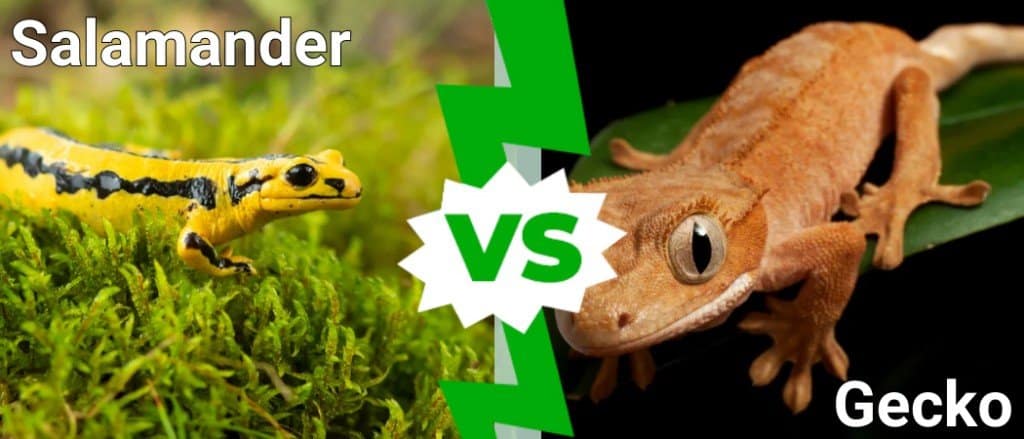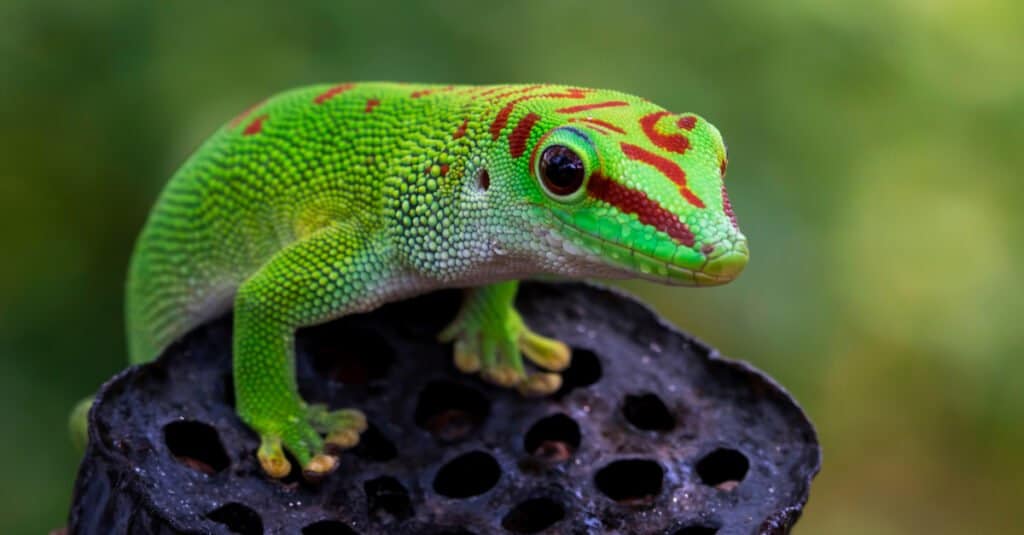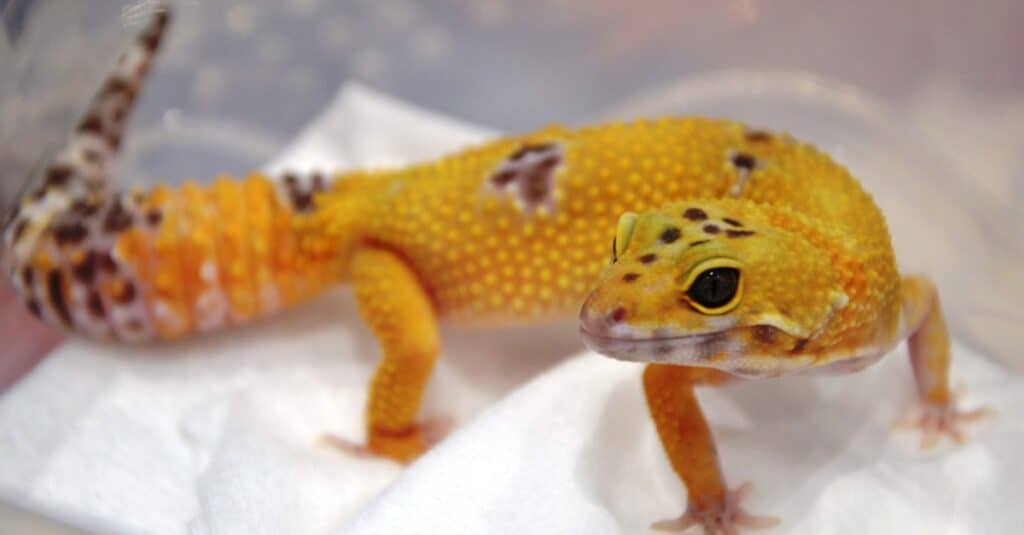At first glance, geckos and salamanders are easy to confuse with each other. After all, their shapes are almost the same. Geckos and salamanders both have colorful patterns, so it’s pretty hard to set the two apart. However similar they are from afar, you’ll realize they have many differences if you look at them closely. To start, salamanders and geckos are not even close relatives as they belong to different classes. Geckos are reptiles, while salamanders are amphibians. That alone gives us a whole new perspective on how these two are entirely different animals. But apart from their classification, what differentiates a salamander vs a gecko? Below, we will explore the key features that set the two animals apart.
Comparing a Salamander and a Gecko

| Salamander | Gecko | |
| Size | – Averages from 4 to 8 inches long, most reach only 6 inches | – Averages from 5 – 24 inches depending on the species |
| Skin | – Moist and smooth, sometimes slimy. Very permeable to water. Absorbent of its surroundings | – Smooth but warty or rough- impermeable to water |
| Diet | – Small animals, insects, spiders, worms, flies, and larvae | – Fruits and insects |
| Habitat | – Lives in water or near water, moist grounds such as creeks, ponds, or under rocks | – Rainforests, mountains, and deserts |
| Care and Training | – Can learn some training routines- best in aquariums with various water amounts | – Smart, quick-learners- suitable for warmer climates and glass terrarium |
The 5 Key Differences Between a Salamander and a Gecko
The main differences between a salamander and a gecko include their size, skins, diet, habitat, and training. Geckos may be very similar to salamanders in body shape and color patterns, but that is where their similarities end. Geckos are reptiles with over 1,500 species, while salamanders are amphibians with over 550 species. Since the two animals are from different classes, they are expected to vary in reproduction processes. Unlike salamander eggs with no shell, geckos produce shelled, amniotic eggs that prevent them from desiccating. These two animals cannot be more different, and we will take an in-depth look at each of their differences.
Salamander vs Gecko: Size

Geckos are typically larger than salamanders.
©Kurit afshen/Shutterstock.com
Salamanders and geckos are often confused because they are about the same size and body shape. However, looking closely, geckos are typically larger than salamanders. Depending on the species, geckos have a wide range of sizes. They can grow from 5 to 24 inches. The smallest gecko, which also happens to be the world’s smallest lizard, only measures 0.6 inches. The New Caledonian giant gecko, the world’s largest gecko, measures 14-17 inches long and weighs 10 ounces. Like geckos, salamanders can also vary in size depending on the species. The smallest can be as short as 0.6 inches, while the largest (Chinese giant salamander) can reach 6 feet. Despite the size of the largest salamander, most salamanders typically grow to an average size of 4 to 8 inches.
Salamander vs Gecko: Skin

Salamanders have skin that’s permeable to water, while geckos have warty and rough skin.
©iStock.com/Vladimir Dyavhkov
One of the main differences you will notice between geckos and salamanders is the variations in their skin textures. Salamanders have moist and slimy skin that is immensely permeable to water. On the other hand, geckos have a thicker, warty, and rough skin covering that is not penetrable by water. Salamanders and geckos shed their skin regularly and eat the lost skin once the procedure is complete.
Salamanders need their skin to be slimy and moist for them to function. The mucus-like substance that their body produces helps them do various bodily functions like making their hearts beat and breathing. Their skins are absorbent not only of water but of chemicals and oils too, making it harmful for them to be touched often.
Salamander vs Gecko: Diet
Both the gecko and salamander are carnivorous. Yet, geckos eat fruits and other plant materials, while salamanders feed on small animals and insects like worms, flies, and spiders. While salamanders feed mainly on other animals, geckos are more fond of plant materials like fruits and flowers. Most aquatic salamanders eat aquatic invertebrates, although larger species also pursue fish or tiny crustaceans and other salamanders. Salamanders prefer slow-moving animals like slugs and snails. They can also eat other amphibians like frogs or small mammals like mice.
On the other hand, geckos include insects, flower nectar, and soft fruit in their diet. The tail of geckos is used in navigation and as fat storage. When food is scarce, geckos rely on this stored fat.
Salamander vs Gecko: Habitat

Salamanders prefer to live in moist areas while geckos prefer arid deserts or trees in rainforests.
©Michael Benard/Shutterstock.com
One of the main differences between geckos and salamanders is where they live. As amphibians, salamanders prefer moist or damp areas like creeks, ponds, brooks, or temperate forests. This type of habitat helps their slimy bodies navigate easier and more quickly. Most salamanders do not leave the water but settle there permanently. In contrast, geckos are not fond of water habitats and do not often go near water. Geckos prefer living in arid deserts, mountainous terrain, or trees in rainforests. Salamanders cannot live in deserts because they need to keep their skin moist, or they would perish. Many gecko species live in trees, with one specific group even evolving with gliding skills and wing-like membranes to help them adapt to arboreal locomotion. Only a few salamander species can climb trees but they prefer not to live there.
Salamander vs Gecko: Care and Training
Geckos are suitable to be kept as pets because they are intelligent and highly trainable. Some geckos are even known to “smile.” Because of their habitat choices, they can also be easily kept in a terrarium with a glass covering, so it will not be easy for them to escape. Most gecko breeds have long lifespans, and they are family-friendly, so it wouldn’t be a challenge to take care of them. Salamanders are nocturnal, so their care needs will be more intricate than geckos. They can learn a few routines but not as fast as geckos. Salamanders prefer damp habitats, so they are suitable for aquariums with sand for them to swim and rest.
The photo featured at the top of this post is © iStock.com/LeitnerR
Thank you for reading! Have some feedback for us? Contact the AZ Animals editorial team.






